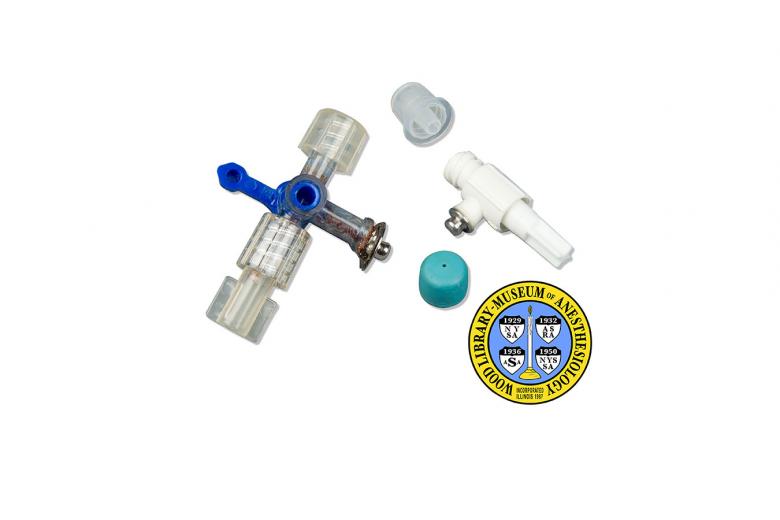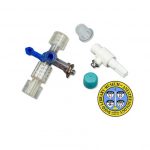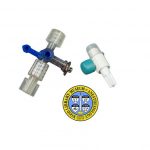Johans Adapter
A central venous catheter is a thin long tube that is placed into one of the body’s large veins for medical treatment or diagnosis. Using a central venous catheter as an electrode to read the heart's electrical activity (electrocardiography) and aid in proper placement of the catheter was suggested as early as 1949 by Hellerstein, Pritchard, and Lewis. This method was made much more viable with the creation of the Arrow-Johans ECG adapter. Anesthesiologist and pain specialist Dr. Thomas G. Johans began to work on early prototypes of the adapter in his home's basement in 1977. Pictured here, on the left, is a replica of one of Dr. Johans’ prototypes with one of the first adapters manufactured for clinical use by Arrow International in 1983. The design was patented in 1987. The adapter is attached to the catheter and helps to transfer and read electrical pulses. In addition to its usefulness for intravascular electrocardiography and catheter placement, Dr. Johans foresaw the use of the adapter to aid in safe and effective injection of local anesthetics to numb parts of the body. Since the adapter first became available it has been found to be useful for a number of other medical procedures, including proper needle and catheter placement for draining fluid from around the heart and epidural anesthesia. Dr. Johans’ innovation has also prompted other manufacturers to produce competing devices.
Catalog Record: Johans Adapter
Two catalog records: akfb, akfa
Access Key: akfb
Accession No.: 1999-04-22-01 A
Title: [Replica of an early prototype of the Arrow-Johans ECG adapter for right
atrial electrocardiography / invented by Thomas G. Johans.]
Author: Johans, Thomas G.
Title variation: Alt Title
Title: Johans electrocardiogram adapter.
Title variation: Alt Title
Title: Johans adaptor.
Title variation: Alt Title
Title: Arrow-Johans ECG adapter.
Title variation: Alt Title
Title: Arrow-Johans RAECG adapter.
Publisher: [Missouri : Thomas G. Johans, 1999].
Physical Descript: 1 adapter : plastic, stainless steel ; 4 x 2.5 x 5 cm. (with caps on).
Subject: Prototypes.
Subject: Electrocardiography – instrumentation.
Subject: Electrocardiography – methods.
Subject: Catheterization, Central Venous – instrumentation.
Subject: Catheterization, Central Venous – methods.
Subject: Analgesia, Epidural – instrumenation.
Subject: Analgesia, Epidural – methods.
Subject: Anesthesia, Conduction – instrumentation.
Subject: Anesthesia, Conduction – methods.
Subject: Anesthesia, Regional – instrumentation.
Subject: Anesthesia, Regional – methods.
Subject: Electric Stimulation – instrumentation.
Note Type: General
Notes: Title based on the name of the first manufactured adapter and on
documentation from the inventor, Thomas G. Johans, MD, given to the WLM when
the replica was donated.
Note Type: General
Notes: The year the replica was made is taken from documentation from the inventor
that is held in the WLM archives.
Note Type: Citation
Notes: Hellerstein HK, Pritchard WH, Lewis RL. Recording of intracavity potentials
through a single-lumen saline filled cardiac catheter. Proc Soc Exp Biol Med.
1949;71(1):58–61.
Note Type: Citation
Notes: Johans TG, Carr G. Peripheral nerve stimulation through a local anesthetic
path: a modified Koons technique. Anesth Analg. 1985;64(12):1217-1219.
Note Type: Citation
Notes: Johans TG. Multiorificed catheter placement with an intravascular
electrocardiographic technique. Anesthesiology. 1986;64(3):411-413.
Note Type: Citation
Notes: Johans TG, inventor; Arrow International, Inc., assignee. Device for making
electrical connection to an electrolyte, and system employing same. US patent
4,644,960. February 24, 1987.
Note Type: Citation
Notes: Johans TG, Mallory DL. Intravascular electrocardiography: a resurrected
technique. J Clin Monit. 1989;5(3):217.
Note Type: Citation
Notes: Johans, TG. Letters and personal papers from the Thomas G. Johans Collection.
Located at: The archives of the Wood Library Museum of Anesthesiology, Park
Ridge, Illinois.
Note Type: Citation
Notes: Tsui BC, Gupta S, Finucane B. Confirmation of epidural catheter placement
using nerve stimulation. Can J Anaesth. 1998;45(7):640-644.
Note Type: Citation
Notes: Wilson RG, Gaer JA. Right atrial electrocardiography in placement of central
venous catheters. Lancet. 1988;1(8583:462-463.
Note Type: Physical Description
Notes: The primary piece of the adapter is plastic three-way stopcock for IV tubing.
The valve is turned so that the stopcock may act as a three way conduit. The
male and one of the female Luer Lock connections is capped. A piece of a 25
gauge needle with a metal hub is glued into the second female Luer Lock, and
an ECG nipple is soldered onto the hub. When viewed facing the male Luer Lock
with the caps in place, the adapter measures approximately 3.9 cm in height,
2.2 cm wide, and 4.8 cm deep.
Note Type: Reproduction
Notes: Photographed by Mr. Steve Donisch on January 14, 2013, with one of the first
Arrow-Johans adapters manufactured for clinical use.
Note Type: Acquisition
Notes: Donated to the WLM by the inventor, Thomas G. Johans, MD.
Note Type: Historical
Notes: Using the catheter as an electrode for electrocardiography (ECG) to aid in
proper placement of central venous catheters was suggested as early as 1949
(Hellerstein, Pritchard, & Lewis). This method was made much more viable with
the creation of the Arrow-Johans ECG adapter. Anesthesiologist and pain
specialist Thomas G. Johans began to work on early prototypes of the adapter
in his home’s basement in 1977. The manufacturer, Arrow International, began
producing the first adapters for clinical use in 1983. The design received a
patent in 1987. In addition to its usefulness for intravascular
electrocardiography and catheter placement, Dr. Johans foresaw the use of the
adapter to aid in safe and effective administration of regional block
anesthetics. Since the adapter first became available it has been found to be
useful for a number of other medical procedures including proper needle and
catheter placement for pericardiocentesis and epidural anesthesia. Dr.
Johans’ innovation has also prompted other manufacturers to produce competing
devices.
Note Type: Exhibition
Notes: Selected for the WLM website (noted February, 2013).
Access Key: akfa
Accession No.: 1999-03-24-01
Title: Arrow-Johans ECG adapter for right atrial electrocardiography (RAECG) /
[invented by Thomas G. Johans] ; manufactured by Arrow International, Inc.
Author: Johans, Thomas G.
Title variation: Alt Title
Title: Johans electrocardiogram adapter.
Title variation: Alt Title
Title: Johans adaptor.
Title variation: Alt Title
Title: Arrow-Johans ECG adapter.
Title variation: Alt Title
Title: Arrow-Johans RAECG adapter.
Publisher: Reading, Pennsylvania : Arrow International, Inc., [1983].
Physical Descript: 1 adapter : plastic, rubber, stainless steel ; 2 x 1.2 x 3.5 cm. (with caps on).
Subject: Electrocardiography – instrumentation.
Subject: Electrocardiography – methods.
Subject: Catheterization, Central Venous – instrumentation.
Subject: Catheterization, Central Venous – methods.
Subject: Analgesia, Epidural – instrumenation.
Subject: Analgesia, Epidural – methods.
Subject: Anesthesia, Conduction – instrumentation.
Subject: Anesthesia, Conduction – methods.
Subject: Anesthesia, Regional – instrumentation.
Subject: Anesthesia, Regional – methods.
Subject: Electric Stimulation – instrumentation.
Note Type: General
Notes: Title taken from original packaging.
Note Type: General
Notes: Year of manufacture based on documentation from the inventor held in the WLM
archives.
Note Type: With
Notes: The adapter is accompanied by the original package (sterile, peel to open
paper and plastic) and printed instructions. The package measures
approximately 19 cm high by 12.5 cm wide. The instructions are printed on a
single piece of paper 14 cm high by 10.2 cm wide. They include “INSTRUCTIONS
FOR USE – RIGHT ATRIAL ELECTROCARDIOGRAPHY”, “INSTRUCTIONS FOR USE –
INTO-ATRIAL OR CENTRAL VENOUS CATHETER TIP PLACEMENT, “CAUTION: ELECTRO-SHOCK
WARNING”, and “TROUBLE SHOOTING TIPS”. The outside of the paper side of the
packaging is printed with a number of marks and informative information,
including “REORDER: EG-04900”, and “CONTROL NO. E-070-5”.
Note Type: Citation
Notes: Hellerstein HK, Pritchard WH, Lewis RL. Recording of intracavity potentials
through a single-lumen saline filled cardiac catheter. Proc Soc Exp Biol Med.
1949;71(1):58–61.
Note Type: Citation
Notes: Johans TG, Carr G. Peripheral nerve stimulation through a local anesthetic
path: a modified Koons technique. Anesth Analg. 1985;64(12):1217-1219.
Note Type: Citation
Notes: Johans TG. Multiorificed catheter placement with an intravascular
electrocardiographic technique. Anesthesiology. 1986;64(3):411-413.
Note Type: Citation
Notes: Johans TG, inventor; Arrow International, Inc., assignee. Device for making
electrical connection to an electrolyte, and system employing same. US patent
4,644,960. February 24, 1987.
Note Type: Citation
Notes: Johans TG, Mallory DL. Intravascular electrocardiography: a resurrected
technique. J Clin Monit. 1989;5(3):217.
Note Type: Citation
Notes: Johans, TG. Letters and personal papers from the Thomas G. Johans Collection.
Located at: The archives of the Wood Library Museum of Anesthesiology, Park
Ridge, Illinois.
Note Type: Citation
Notes: Tsui BC, Gupta S, Finucane B. Confirmation of epidural catheter placement
using nerve stimulation. Can J Anaesth. 1998;45(7):640-644.
Note Type: Citation
Notes: Wilson RG, Gaer JA. Right atrial electrocardiography in placement of central
venous catheters. Lancet. 1988;1(8583:462-463.
Note Type: Physical Description
Notes: On first glance the adapter looks like a three-way stopcock for IV tubing.
The adapter has a male and a female Luer Lock connection, but rather than a
third Luer Lock there is a stainless steel male ECG contact or nipple. The
adapter is plastic with the exception of the stainless steel contact and its
rubber protective cap. The caps for the Luer Locks are also plastic. When
viewed facing the male Luer Lock, with the caps all in place, the adapter
measures approximately 1.9 cm in height, 1.2 cm wide, and 3.5 cm deep. With
the caps off it measures approximately 1.6 cm in height, 1 cm wide, and 2 cm
deep.
Note Type: Reproduction
Notes: Photographed by Mr. Steve Donisch on January 14, 2013, with a replica of an
early conceptual prototype made by Dr. Thomas G. Johans in his basement,
using a standard stopcock, A 25 gauge needle with a metal hub soldered to an
ECG nipple, and rubber cement.
Note Type: Acquisition
Notes: Donated to the WLM by the inventor, Thomas G. Johans, MD.
Note Type: Historical
Notes: Using a central venous catheter as an electrode for electrocardiography (ECG)
to aid in proper placement of the catheter was suggested as early as 1949 by
Hellerstein, Pritchard, and Lewis. This method was made much more viable with
the creation of the Arrow-Johans ECG adapter. Anesthesiologist and pain
specialist Thomas G. Johans began to work on early prototypes of the adapter
in his home’s basement in 1977. The manufacturer, Arrow International, began
producing the first adapters for clinical use in 1983. The design received a
patent in 1987. In addition to its usefulness for intravascular
electrocardiography and catheter placement, Dr. Johans foresaw the use of the
adapter to aid in safe and effective administration of regional block
anesthetics. Since the adapter first became available it has been found to be
useful for a number of other medical procedures including proper needle and
catheter placement for pericardiocentesis and epidural anesthesia. Dr.
Johans’ innovation has also prompted other manufacturers to produce competing
devices.
Note Type: Exhibition
Notes: Selected for the WLM website (noted February, 2013).



